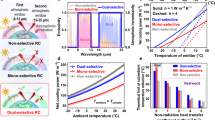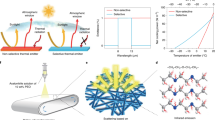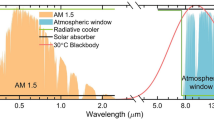Abstract
Radiative cooling is a passive cooling strategy with zero consumption of electricity that can be used to radiate heat from buildings to reduce air-conditioning requirements. Although this technology can work well during optimal atmospheric conditions at night, it is essential to achieve efficient cooling during the daytime when peak cooling demand actually occurs. Here we report an inexpensive planar polydimethylsiloxane (PDMS)/metal thermal emitter thin film structure, which was fabricated using a fast solution coating process that is scalable for large-area manufacturing. By performing tests under different environmental conditions, temperature reductions of 9.5 °C and 11.0 °C were demonstrated in the laboratory and an outside environment, respectively, with an average cooling power of ~120 W m–2 for the thin film thermal emitter. In addition, a spectral-selective structure was designed and implemented to suppress the solar input and control the divergence of the thermal emission beam. This enhanced the directionality of the thermal emissions, so the emitter’s cooling performance was less dependent on the surrounding environment. Outside experiments were performed in Buffalo, New York, realizing continuous all-day cooling of ~2–9 °C on a typical clear sunny day at Northern United States latitudes. This practical strategy that cools without electricity input could have a significant impact on global energy consumption.
This is a preview of subscription content, access via your institution
Access options
Access Nature and 54 other Nature Portfolio journals
Get Nature+, our best-value online-access subscription
$29.99 / 30 days
cancel any time
Subscribe to this journal
Receive 12 digital issues and online access to articles
$119.00 per year
only $9.92 per issue
Buy this article
- Purchase on Springer Link
- Instant access to full article PDF
Prices may be subject to local taxes which are calculated during checkout





Similar content being viewed by others
Data availability
The data that support the findings of this study are available from the corresponding authors on request.
References
Kelso, J. K. 2011 Buildings Energy Data Book (US Department of Energy, 2012).
Chu, S. & Majumdar, A. Opportunities and challenges for a sustainable energy future. Nature 488, 294–303 (2012).
Segar, C. Renewable augment gas—Saudi energy mix. J. Int. Energy Agency 7, 40–41 (2014).
Mahdavinejad, M. & Javanrudi, K. Assessment of ancient fridges: a sustainable method to storage ice in hot-arid climates. Asian Cult. Hist. 4, 133–139 (2012).
Catalanotti, S. et al. The radiative cooling of selective surfaces. Sol. Energy 17, 83–89 (1975).
Fan, S. Thermal photonics and energy applications. Joule 1, 264–273 (2017).
Hossain Md, M. & Gu, M. Radiative cooling: principles, progress, and potentials. Adv. Sci. 3, 1500360 (2016).
Sun, X., Sun, Y., Zhou, Z., Alam Muhammad, A. & Bermel, P. Radiative sky cooling: fundamental physics, materials, structures, and applications. Nanophotonics 6, 997–1015 (2017).
Buddhiraju, S., Santhanam, P. & Fan, S. Thermodynamic limits of energy harvesting from outgoing thermal radiation. Proc. Natl Acad. Sci. USA 115, E3609–E3615 (2018).
Raman, A. P., Anoma, M. A., Zhu, L., Rephaeli, E. & Fan, S. Passive radiative cooling below ambient air temperature under direct sunlight. Nature 515, 540–544 (2014).
Zhai, Y. et al. Scalable-manufactured randomized glass-polymer hybrid metamaterial for daytime radiative cooling. Science 355, 1062–1066 (2017).
Mandal, J. et al. Hierachically porous polymer coatings for highly efficient passive daytime radiative cooling. Science 362, 315–319 (2018).
Zhu, L., Raman, A., Wang, K. X., Anoma, M. A. & Fan, S. Radiative cooling of solar cells. Optica 1, 32–38 (2014).
Li, W., Shi, Y., Chen, K., Zhu, L. & Fan, S. A comprehensive photonic approach for solar cell cooling. ACS Photonics 4, 774–782 (2017).
Zhu, L., Raman, A. P. & Fan, S. Radiative cooling of solar absorbers using a visibly transparent photonic crystal thermal blackbody. Proc. Natl Acad. Sci. USA 112, 12282–12287 (2015).
Shi, Y., Li, W., Raman, A. & Fan, S. Optimization of multilayer optical films with a memetic algorithm and mixed integer programming. ACS Photonics 5, 684–691 (2018).
Rephaeli, E., Raman, A. & Fan, S. Ultrabroadband photonic structures to achieve high-performance daytime radiative cooling. Nano Lett. 13, 1457–1461 (2013).
Yuan, H. et al. Effective, angle-independent radiative cooler based on one-dimensional photonic crystal. Opt. Express 26, 27885–27893 (2018).
Chen, Z., Zhu, L., Raman, A. & Fan, S. Radiative cooling to deep sub-freezing temperatures through a 24-h day–night cycle. Nat. Commun. 7, 13729 (2016).
Bhatia, B. et al. Passive directional sub-ambient daytime radiative cooling. Nat. Commun. 9, 5001 (2018).
Goldstein, E. A., Raman, A. P. & Fan, S. Sub-ambient non-evaporative fluid cooling with the sky. Nat. Energy 2, 17143 (2017).
Angus, R. G. & Geoff, B. S. A subambient open roof surface under the mid-summer sun. Adv. Sci. 2, 1500119 (2015).
Lu, X., Xu, P., Wang, H., Yang, T. & Hou, J. Cooling potential and applications prospects of passive radiative cooling in buildings: the current state-of-the-art. Renew. Sustain. Energy Rev. 65, 1079–1097 (2016).
Lee, G. J., Kim, Y. J., Kim, H. M., Yoo, Y. J. & Song, Y. M. Colored, daytime radiative coolers with thin-film resonators for aesthetic purposes. Adv. Opt. Mater. 6, 1800707 (2018).
Hoyt, T., Arens, E. & Zhang, H. Extending air temperature setpoints: simulated energy savings and design considerations for new and retrofit buildings. Build. Environ. 88, 89–96 (2015).
Li, W., Shi, Y., Chen, Z. & Fan, S. Photonic thermal management of coloured objects. Nat. Commun. 9, 4240 (2018).
Li, T. et al. A radiative cooling structural material. Science 364, 760–763 (2019).
Hsu, P.-C. et al. Radiative human body cooling by nanoporous polyethylene textile. Science 353, 1019–1023 (2016).
Hsu, P.-C. et al. A dual-mode textile for human body radiative heating and cooling. Sci. Adv. 3, e1700895 (2017).
Kou, J.-l, Jurado, Z., Chen, Z., Fan, S. & Minnich, A. J. Daytime radiative cooling using near-black infrared emitters. ACS Photonics 4, 626–630 (2017).
Atiganyanun, S. et al. Effective radiative cooling by paint-format microsphere-based photonic random media. ACS Photonics 5, 1181–1187 (2018).
Peng, Y. et al. Nanoporous polyethylene microfibres for large-scale radiative cooling fabric. Nat. Sustain. 1, 105–112 (2018).
Nilsson, T. M. J. & Niklasson, G. A. Radiative cooling during the day: simulations and experiments on pigmented polyethylene cover foils. Sol. Energy Mater. Sol. Cells 37, 93–118 (1995).
Huang, Z. & Ruan, X. Nanoparticle embedded double-layer coating for daytime radiative cooling. Int. J. Heat Mass Transf. 104, 890–896 (2017).
Dobson, K. D., Hodes, G. & Mastai, Y. Thin semiconductor films for radiative cooling applications. Sol. Energy Mater. Sol. Cells 80, 283–296 (2003).
Gentle, A. R., Nuhoglu, A., Arnold, M. D. & Smith, G. B. 3D printable optical structures for sub-ambient sky cooling. Proc. SPIE 10369, 103690B (2017).
Gentle, A. R. & Smith, G. B. Angular selectivity: impact on optimised coatings for night sky radiative cooling. Proc. SPIE 7404, 74040J (2009); https://doi.org/10.1117/12.825722.
Smith, G. B. Amplified radiative cooling via optimised combinations of aperture geometry and spectral emittance profiles of surfaces and the atmosphere. Sol. Energy Mater. Sol. Cells 93, 1696–1701 (2009).
Srinivasan, A., Czapla, B., Mayo, J. & Narayanaswamy, A. Infrared dielectric function of polydimethylsiloxane and selective emission behavior. Appl. Phys. Lett. 109, 061905 (2016).
Greffet, J.-J. et al. Coherent emission of light by thermal sources. Nature 416, 61–64 (2002).
Granqvist, C. G. & Hjortsberg, A. Radiative cooling to low temperatures: General considerations and application to selectively emitting SiO films. J. Appl. Phys. 52, 4205–4220 (1981).
Acknowledgements
This work was partially supported by the National Science Foundation (grant nos. IIP-1745846, ECCS-1507312, CBET-1445934 and ECCS-1425648).
Author information
Authors and Affiliations
Contributions
Q.G., B.O. and Z.Y conceived the idea and supervised the project. L.Z., H.S., J.L., E.S. and T.N. executed the experiments. All authors contributed to the analysis of the experimental results and modelling. L.Z., H.S., Z.Y., B.O. and Q.G. wrote the manuscript. All authors reviewed the manuscript.
Corresponding authors
Ethics declarations
Competing interests
Q.G. and Z.Y. have founded a company, Sunny Clean Water LLC, seeking to commercialize the results reported in this paper.
Additional information
Publisher’s note: Springer Nature remains neutral with regard to jurisdictional claims in published maps and institutional affiliations.
Supplementary information
Supplementary Information
Supplementary Figs. 1–9, Notes 1–6 and Refs. 1–3
Supplementary Video 1
Short clip showing application of PDMS coating to metal.
Rights and permissions
About this article
Cite this article
Zhou, L., Song, H., Liang, J. et al. A polydimethylsiloxane-coated metal structure for all-day radiative cooling. Nat Sustain 2, 718–724 (2019). https://doi.org/10.1038/s41893-019-0348-5
Received:
Accepted:
Published:
Issue Date:
DOI: https://doi.org/10.1038/s41893-019-0348-5
This article is cited by
-
Bilateral passive thermal management for dynamical temperature regulation
Scientific Reports (2024)
-
A dual-selective thermal emitter with enhanced subambient radiative cooling performance
Nature Communications (2024)
-
Promising thermal photonic management materials for sustainable human habitat
Nano Research (2024)
-
Scalable and sustainable hierarchical-morphology coatings for passive daytime radiative cooling
Advanced Composites and Hybrid Materials (2024)
-
Regeneration of Pea-Pod-Like Cellulose Acetate Fibers as Aerogel-Derived Boards for Building Thermal Regulation and Carbon Reduction
Advanced Fiber Materials (2024)



